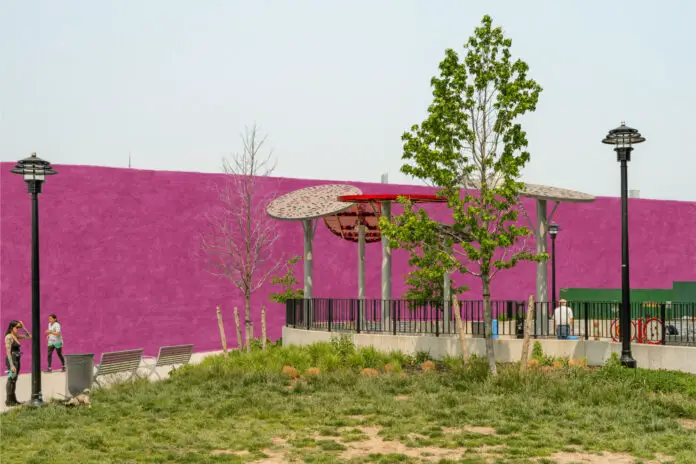Close to 200 Highlands residents heeded the invitation of the Mayor and Council to attend a special meeting last Monday night to listen to experts and ask questions concerning the proposed flood wall encompassing the borough that the Army Corps of Engineers has been designing for years.
After three hours of explanations, questions, responses, charts, reactions and opinions, Mayor Carolyn Broullon accomplished what she had set out to do……provide as much information as possible and get as much response as possible from residents before they vote on a non-binding question on the November 5 ballot.

In thanking everyone for attending the meeting, and urging at its onset for all to be respectful and courteous, knowing emotions are running high on the possible construction, Mayor Broullon turned the meeting over to the professionals from the Army Corps of Engineers and the New Jersey Department of Environmental Protection to present their plans and what is necessary for them to be carried out.
While most of those present were aware of many aspects of the federal and state proposal, most opposed the idea of a 14-foot-high concrete flood wall extending from the Veterans Park area to west of Gravelly Point close to One Willow St. which could be constructed no earlier than 2030.
Residents objected to the possibility of eminent domain to acquire some of the land necessary for the current plans, others charged officials at the state and federal levels have not been transparent, others called for completion of repairs to the borough’s pumping stations before proceeding with further projects to stop flooding in a borough accustomed to high water at storm and moon tides.
There was applause when a resident charged “it’s always the government, but it’s the people who suffer,” and termed the proposal as known as “a really, really bad deal.” There were groans when a resident painted a picture of “a rusted wall hiding the water instead of the nice little fishing town Highlands really is.” There were more groans of discontent when another resident said “the town disappears when the wall goes up,” and questions concerning everything from how many buildings would be saved with construction of the wall to “how can we say yes when we don’t even know the design of the wall?
In the end, it was clear that while the question on the ballot November 5 is non-binding, it will give the governing body a strong message from the voters how they feel about the Army Corps continuing designing its idea for what the experts feel is the best solution and one already workable in other areas of the country against rising ocean tides studies show will continue to continue even more rise in future decades.
A Yes vote will give the governing body confidence they are doing the will of the majority by not taking any action and enabling the Army Corps and state DEP to proceed with further plans without any signatures on any contracts that would seal the deal. A no vote would give the state and federal agencies the firm idea the borough is not interested in saving the borough from predicted extremely high tidal waters anytime in the future. A No vote would probably put this particular program to death and could possibly have the state take a more cautious look at funding future flood control projects for the borough.
In either case, the decision made by the current Mayor and Council does not impact any decision of a future governing body until any contracts and agreements are signed between the borough and the state DEP.

State DEP Commissioner Shawn LaTourette and DEP Assistant Commissioner Jennifer Moriarty presented most of the background and study information of the proposal that was first introduced in 2016 in a clearly presented explanation on work on shore protection from Long Branch to Keansburg. LaTourette said that shore surge has always been the biggest complaint of residents throughout New Jersey, from rivers as well as tides. He noted that while plans for the proposed flood wall for Highlands are not fully designed yet, and the Corps predicts some years to go before completion, the idea of a flood wall has been found to be the most effective link meeting the storm surge challenge wherever implemented. “If we do not do it know, we will lose,” LaTourette opined, “this is the moment” to ensure safety. He said the purpose of the meeting was to keep residents informed and to enable the state to decide is if it should continue working with the Army Corps on completing plans for a wall in the future.
Congressman Frank Pallone’s District Director Matthew Montekio was present the entire three hours to report back to the Congressman on the opinions of the residents. He carried Pallone’s message that there is truth in the studies that the risk of future higher flooding is “real and increasing.” He explained the experts were not present at the meeting to convince residents to proceed, but rather to advise them of the risk the borough faces and to ensure Congressional funds authorized for flood work are available and used.
Assistant Commissioner Moriarity cited the vulnerability of properties in coastal storms, citing the sea level of Highlands, and showing how flood waters have increased and will continued to increase over the next 30 decades. Borough Engineer Joseph Rafferty also quoted high water figures by the year 2050. Raferty also explained that Zone 1 of a comprehensive overall solution to water programs are the borough’s three pump stations which forcibly move out high water, zone 2 is the runoff from Route 36 and Zone 3 is the Monmouth Hill runoff and associated silt, noting the borough is working with the Army Corps on two of the projects which will result in more safety against flooding.
The proposed wall, although its design and completed plan are yet to be completed, would definitely be 14 feet high, and would be completed sometime no sooner than seven years from now. It would require negotiations for property where necessary for the plan and there could be configurations, different proposals for the appearance of the wall and other changes before the design is complete.
Residents expressed doubt in FEMA funds, several citing their frustration with both FEMA funding and flood insurance in the wake of the borough’s devastation from Sandy and the lack of access to beaches, Sea Streak, marinas and other aspects that are a historic part of Highlands.
Cost of the project was set at $148 million, with Highlands funding approximately $13 million. But here were no firm answers on how the wall impacts flood insurance costs, the tax rate and future property values. It was suggested that an updated study be made of the number of buildings that would be protected by the wall, so the public could be aware of the ratio saved versus the overall costs of a wall.
Residents in favor of continuing the study also asked that consideration be given to have another vote after more up to date information is obtained, plans modified and a study done on property sales and the negative impact on taxes should property values be lowered with the change in the borough’s appearance and design.
Council members decline to offer any comments on their personal opinions for the federal and state proposal, preferring to wait until after the Nov. 5 vote to see the opinion of the public before deciding on any future action.



